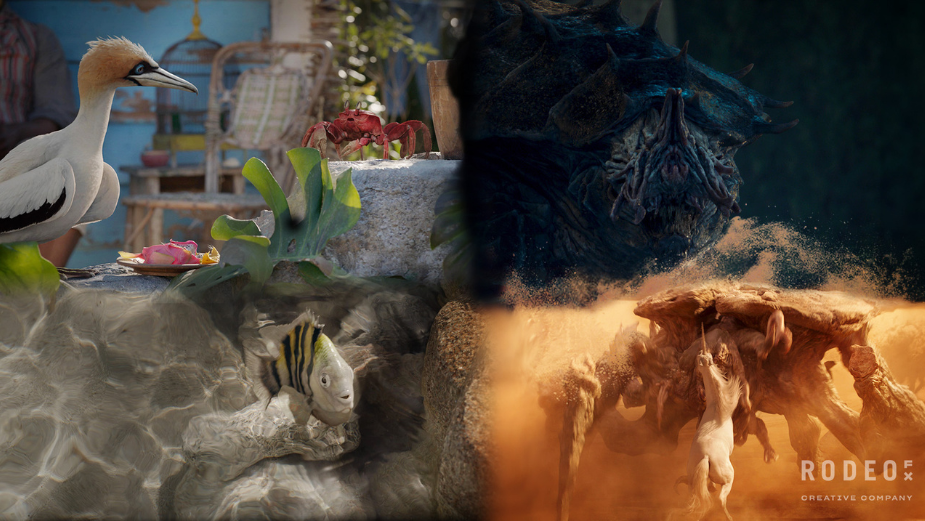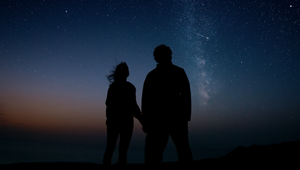
From Cuddly Critters to Creature Discomforts: A Masterclass From Rodeo FX

There’s both an art and a science to CG animated creatures. On the one hand, they feel fantastical - an otherworldly beast or an adorable animal that has its own personality. But on the other hand, they need to feel disarmingly real. As though you could take them home as a pet, or they could be about to leap out from behind your seat and attack.
Few studios understand the unique nature of that creative challenge better than Rodeo FX. Whether it be jaw-dropping Sci Fi like Apple TV’s Foundation and Denis Villeneuve's Dune, or fantastical worlds depicted in the likes of Amazon’s The Rings of Power and the Fantastic Beasts movies, the Rodeo team are no strangers to crafting alternate realities and the creatures who reside within them.
Keen to learn more about the process behind bringing these animated critters to life on-screen, LBB caught up with two Rodeo team members with experience on the most high-profile of creature design and animation projects respectively.
Philip Harris-Genois is an asset supervisor and lead modeller who helped design some of the most terrifying beasts in Netflix’s The Witcher series, whilst Oscar Carambano is an animation supervisor whose work involved giving visual life to beloved characters such as Flounder, Scuttle, and Sebastian in Disney’s The Little Mermaid movie. Between them, Oscar and Philip reflected on the art, design, and animation behind top-tier CG creatures.
The Art of the Iconic
On a conceptual level, The Witcher presented an opportunity - and a challenge - like no other for Philip and the Rodeo team. Whilst there is a rich history of reference points for The Witcher as an intellectual property through Andrzej Sapkowski’s original novels and the now-iconic smash hit video games, the TV series was set to be its own entity. Separate, but connected, to the previous iterations we’d seen. “We wanted to ensure that the themes and the tone of The Witcher were incorporated into our work”, recalls Philip. “It was fantasy - but a dark, gritty, and gruesome version of fantasy”.
Looking at the design of fearsome creatures from season three like The Pit Monster and the Jackapace, it’s clear to see that approach shining through. “Whilst these monsters are obviously from this fantasy universe, it was important to make them look and feel believable - at least within the context of that universe”, explains Philip. “You have to understand that, as far as you are concerned, this is a living creature. So the best thing you can do is relate the design to real world animals, almost as if it’s some kind of twisted evolution of something you see in the real world”.
That philosophy is written all across the design of the creatures we see on-screen - and it’s no accident. In fact, it’s the result of a meticulous and masterful grasp of detail that’s spearheaded by Rodeo’s team. “We need to think about the creature’s skin, and how it reacts to objects it touches”, notes Philip. “Is it slimy or scaly, smooth or rough? How would we expect it to react to or reflect light, and would that change depending on the creature's movements? These are all questions that we need to ask throughout the process”.
On the other side of the creature coin, Oscar’s task as part of Rodeo’s animation team for The Little Mermaid was to delight audiences rather than terrify them. Bringing to life the designs for Flounder, Scuttle, and Sebastian, Oscar relished the opportunity to work with such legendary creatures.
“Look, I’m an animator - so of course I am in love with the classics. The original Little Mermaid movie holds a special place in my heart”, he tells LBB. “So the main goal we had in mind was to give new audiences the same feeling that the original gave to us. And, in doing so, communicate through movement that Flounder is innocent, Scuttle is eccentric, and Sebastian is responsible”.
On top of that, Oscar needed to ensure that the 3D CG critters had that most important of qualities from across the history of Disney’s animated back catalogue: Cuteness.
“We drew inspiration from real-world animal interactions with humans to get that intangible quality of cuteness to come through”, he says. “Like when a small animal simply leans forwards towards you and opens its eyes, for example”.
Whilst Oscar needed to work with iconic characters, Philip needed to design his own. “I always find the silhouette to be so important”, he says when asked about the secrets behind great creature design. “You should always aim to create something that can be identified purely by its own shadow”.
According to Philip, however, that wasn’t the biggest challenge his team faced. “For me, the most important thing to consider is always the movement of the actor your creatures will be seen alongside”, he suggests. “Because if Geralt is swinging his sword three times through the air, you’d better make sure your creature is reacting to those swings in a satisfying way”.
On which note, there’s also a certain element of the macabre to virtually all of the team’s creature design work for The Witcher. Specifically, that the creatures they work to bring to life are invariably designed to die. “You can get quite philosophical when you start to look at it that way”, chuckles Philip. “And of course you get attached to these creatures when you’ve been working on them for hundreds of hours! So to see them cut down after a few minutes of screentime can be tough”.
But having said that, there’s still an immense feeling of satisfaction when it comes to a creature’s final moments - one that Philip hopes will be shared by the audience. “You want to give all of your creatures the send-off that they deserve”, he says. “One that feels natural to them, and gives an emphatic sense of finality to a tricky fight scene or chase”.
And of course, all of that needs to be achieved by working in tandem with a show’s animators. Throughout the entire project, continues Philip, there’s a constant line of communication between Rodeo’s designers and animators.
“Animation Is Where It Come Alive”
In addition to being an animation supervisor, there’s another title that Oscar might consider adopting: Body language expert. Because giving life to the animated characters of The Little Mermaid in a way that’s true to their respective voice actors is a task that requires an innate, almost instinctive understanding of human expressions.
“When we’re working on a project like this, we’ll have access to what’s called ADR - automated dialogue replacement”, notes Oscar. “This allows us to see the actors during the voice recording sessions, and get a more physical sense of their performance”.
By way of example, Oscar refers to a clip of Awkwafina - the voice of Scuttle - gesturing with her hand to emphasise a particular word. “Obviously, birds don’t have human hands - but we still wanted to incorporate that gesture”, says Oscar. “And so, we decided to have the bird’s neck move in a similar motion to underline the same point”.
At which point, credit is due to the rigging team - an essential part of ensuring that what we see on-screen feel credible and fleshed out when it comes to animation. “They are the link between asset management and animation”, as Oscar puts it. “They put the ‘controls’ or ‘strings’ on the assets in order that we animators can move them like puppeteers”.
It’s a subtle but extremely effective way of communicating - and a way to see the original voice actor’s performance shine through in an animated character. “Animation is crucial to believability”, as Philip puts it.
“Sometimes we take some liberties”, admits Oscar. “After all, animators are kind of like backstage actors, so to speak”.
And that, ultimately, is the point at which art and science blur when it comes to effective CG creatures. Whilst the technology used is top notch, there will always be a little bit of artistry - a little bit of humanity - involved in the best, most emotionally resonant creatures work.
So whether it’s terrifying monsters or cute critters, there’s no substitute for the best expertise in the world of CG creatures.
To see more of Rodeo's incredible creature work, check out rodeofx.com















